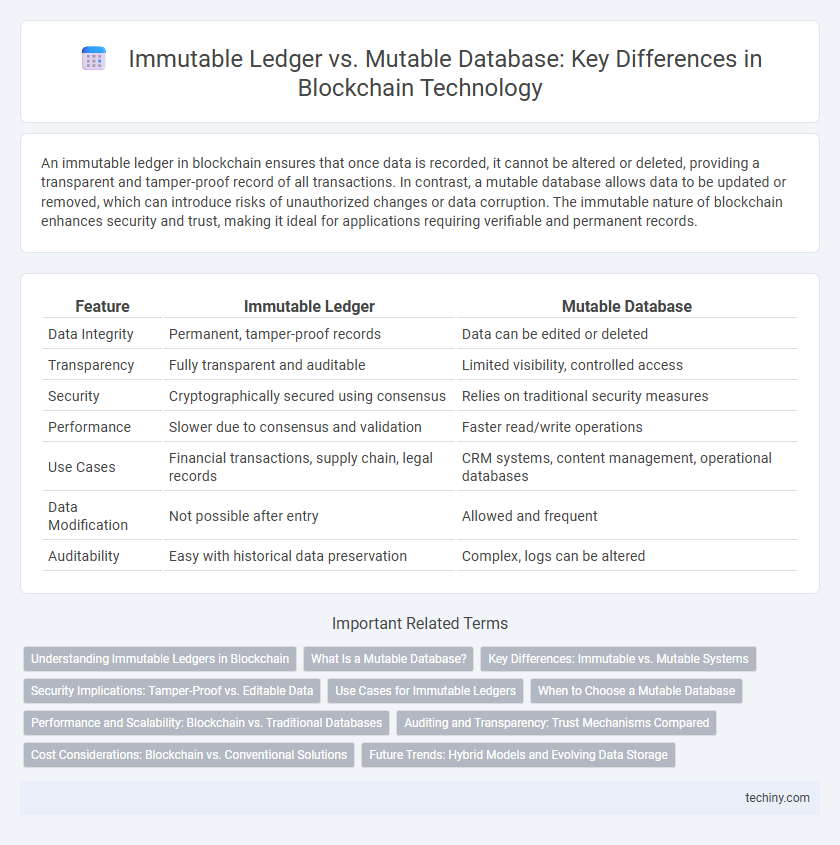An immutable ledger in blockchain ensures that once data is recorded, it cannot be altered or deleted, providing a transparent and tamper-proof record of all transactions. In contrast, a mutable database allows data to be updated or removed, which can introduce risks of unauthorized changes or data corruption. The immutable nature of blockchain enhances security and trust, making it ideal for applications requiring verifiable and permanent records.
Table of Comparison
| Feature | Immutable Ledger | Mutable Database |
|---|---|---|
| Data Integrity | Permanent, tamper-proof records | Data can be edited or deleted |
| Transparency | Fully transparent and auditable | Limited visibility, controlled access |
| Security | Cryptographically secured using consensus | Relies on traditional security measures |
| Performance | Slower due to consensus and validation | Faster read/write operations |
| Use Cases | Financial transactions, supply chain, legal records | CRM systems, content management, operational databases |
| Data Modification | Not possible after entry | Allowed and frequent |
| Auditability | Easy with historical data preservation | Complex, logs can be altered |
Understanding Immutable Ledgers in Blockchain
Immutable ledgers in blockchain technology ensure data integrity by preventing any alteration or deletion of recorded transactions, contrasting with mutable databases that allow changes. This permanence guarantees transparency, traceability, and security, making blockchain ideal for applications like financial services, supply chain management, and digital identity verification. The cryptographic hashing and consensus mechanisms underpinning immutable ledgers further enhance resistance to fraud and unauthorized modifications.
What Is a Mutable Database?
A mutable database allows data to be modified, updated, or deleted after it is initially recorded, offering flexibility for corrections and real-time changes. In contrast to an immutable ledger in blockchain technology, mutable databases do not inherently preserve a permanent history of transactions, making them more vulnerable to data tampering and unauthorized alterations. Common mutable databases include SQL and NoSQL systems, widely used for their adaptability in dynamic data environments.
Key Differences: Immutable vs. Mutable Systems
Immutable ledgers record transactions permanently, ensuring data integrity and transparency by preventing any alterations. Mutable databases allow data modifications, enabling updates and deletions tailored for dynamic environments but posing risks to data consistency. Key differences lie in trust models, with immutable ledgers relying on cryptographic proof and consensus, whereas mutable systems depend on access controls and traditional database management.
Security Implications: Tamper-Proof vs. Editable Data
An immutable ledger in blockchain ensures tamper-proof data by cryptographically linking each block, preventing unauthorized alterations and enhancing trustworthiness. Mutable databases allow edits, increasing flexibility but exposing data to risks of unauthorized changes and fraud. The security advantage of immutable ledgers lies in their transparency and resistance to tampering, critical for applications requiring reliable audit trails.
Use Cases for Immutable Ledgers
Immutable ledgers provide unparalleled security and transparency, making them ideal for financial transactions, supply chain management, and digital identity verification where data integrity is critical. They ensure tamper-proof records by preventing any alteration once information is recorded, which is essential for regulatory compliance and audit trails. Use cases include cryptocurrency transactions, provenance tracking of goods, and secure voting systems, leveraging blockchain's decentralized nature to enhance trust and accountability.
When to Choose a Mutable Database
A mutable database is ideal for applications requiring frequent updates, deletions, and real-time data modifications, such as traditional business operations or dynamic content management systems. It offers flexibility and efficiency in scenarios where data integrity is managed by trusted parties and immediate rollback or corrections are necessary. Enterprises prioritize mutable databases when performance, scalability, and data mutability outweigh the need for tamper-proof audit trails provided by immutable ledgers.
Performance and Scalability: Blockchain vs. Traditional Databases
Blockchain's immutable ledger ensures data integrity through decentralized consensus mechanisms, but this often results in slower transaction speeds and limited scalability compared to traditional databases. In contrast, mutable databases offer higher performance and scalability by allowing direct data modification and centralized control, enabling faster read/write operations suited for large-scale applications. The trade-off between blockchain's security and transparency versus traditional databases' efficiency must be assessed based on specific use cases.
Auditing and Transparency: Trust Mechanisms Compared
Immutable ledgers in blockchain technology provide a tamper-proof record of transactions, enhancing auditing accuracy and transparency by ensuring all data remains unaltered and verifiable. Mutable databases allow data modification, which can obscure audit trails and reduce trustworthiness, increasing the risk of fraud or errors. The inherent immutability in blockchain enforces trust mechanisms by maintaining a secure, transparent, and permanent history, critical for regulatory compliance and stakeholder confidence.
Cost Considerations: Blockchain vs. Conventional Solutions
Immutable ledgers in blockchain incur higher costs due to continuous consensus mechanisms, data replication across multiple nodes, and energy-intensive cryptographic operations. Conventional mutable databases offer lower operational expenses by enabling direct data modification without the need for global consensus or extensive redundancy. Organizations must weigh higher blockchain infrastructure costs against the value of enhanced security, transparency, and auditability in decision-making.
Future Trends: Hybrid Models and Evolving Data Storage
Emerging hybrid models combine immutable blockchain ledgers with mutable databases to balance transparency and flexibility in data management. This integration enables businesses to maintain secure, tamper-proof records while allowing selective data updates and regulatory compliance. Future trends emphasize evolving data storage solutions leveraging both decentralized blockchain technology and adaptable database architectures to optimize scalability and efficiency.
Immutable ledger vs Mutable database Infographic

 techiny.com
techiny.com